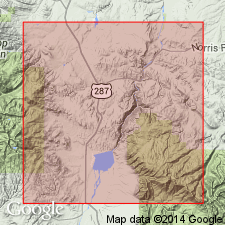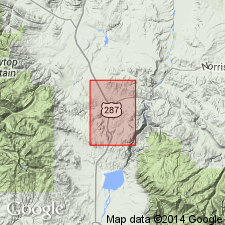
- Usage in publication:
-
- Red Bluff formation
- Modifications:
-
- First used
- Dominant lithology:
-
- Siltstone
- Conglomerate
- Breccia
- AAPG geologic province:
-
- Montana folded belt
Summary:
Named "tentatively" for town of Red Bluff, Madison Co, MT, Montana folded belt province, where unit is best exposed. Type not designated. [Author presumably intends Red Bluff to be an informal unit; term "formation" should only be used for formal nomenclature.] Occurs between towns of Norris and Red Bluff along highway between Anceny and Norris, and south of highway; one small patch occurs north of highway opposite Norris Hot Springs. Lithology consists of well sorted and indurated fine siltstone to coarse conglomerate and breccia; detritus is mostly of igneous origin derived from local exposures of Tobacco Root stock; also includes some rounded pieces of Precambrian metamorphic rocks. Beds range from 3 in to 5 ft thick and are mainly deep red in color, with purple, yellow, and white layers interspersed. Total thickness of unit not discussed. Has progressively less silica cement away from Norris Hot Springs. Geologic map. Represents early phase of sequence of mid-Cenozoic rocks. Age is not known though is younger than Cenozoic Tobacco Root stock.
Source: GNU records (USGS DDS-6; Denver GNULEX).

- Usage in publication:
-
- Red Bluff Formation*
- Modifications:
-
- Named
- Dominant lithology:
-
- Siltstone
- Sandstone
- Conglomerate
- Mudstone
- Diamictite
- AAPG geologic province:
-
- Montana folded belt
Summary:
Tentatively named by Andretta and Alsup (1960); here formally named. Divided into two informal members: a lower diamictite member and an upper member. No complete section exposed; type locality for diamictite member is along boundary between SE/4 sec. 14 and NE/4 sec. 23, T3S, R1W; type locality for upper member is along unnamed creek in W/2 sec. 13, T3N, R1W, Madison Co, MT, Montana folded belt province. Mapped in east central part of quad south of Springs Creek. Diamictite member (Eocene) consists of subrounded to well-rounded, clast-rich, matrix-supported, moderately well indurated bouldery diamictite composed mostly of clasts of granodiorite or quartz monzonite of Tobacco Root batholith. Diamictite member probably deposited by catastrophic debris flows; is approximately equivalent to Eocene Sphinx Conglomerate. Upper member (Eocene and Oligocene) consists of white and light-yellowish-brown siltstone, sandstone, conglomerate, and subordinate brick-red and maroon mudstone and siltstone; locally tuffaceous; beds typically 0.5-2 m thick; most clasts are of Archean gneiss and vein or pegmatitic quartz. Upper member may be partly equivalent to Oligocene Dunbar Creek Member of Renova Formation. Thicknesses: lower member exceeds 30 m; upper member exceeds 100 m. Younger than Eocene to Miocene basalts; older than Pliocene or Pleistocene landslide deposits. Eocene and Oligocene age.
Source: GNU records (USGS DDS-6; Denver GNULEX).
For more information, please contact Nancy Stamm, Geologic Names Committee Secretary.
Asterisk (*) indicates published by U.S. Geological Survey authors.
"No current usage" (†) implies that a name has been abandoned or has fallen into disuse. Former usage and, if known, replacement name given in parentheses ( ).
Slash (/) indicates name conflicts with nomenclatural guidelines (CSN, 1933; ACSN, 1961, 1970; NACSN, 1983, 2005, 2021). May be explained within brackets ([ ]).

